Washington Dulles International Airport, typically referred to as Dulles International Airport, Dulles Airport, Washington Dulles or simply Dulles, is an international airport in the Eastern United States, located in Loudoun County and Fairfax County in Virginia, 26 miles (42 km) west of Downtown Washington, D.C.
Opened in 1962, it is named after John Foster Dulles (1888–1959), the 52nd U.S. Secretary of State who served under President Dwight D. Eisenhower.
The Dulles main terminal is a well-known landmark designed by Eero Saarinen. Operated by the Metropolitan Washington Airports Authority, Washington Dulles Airport occupies 13,000 acres (20.3 sq mi; 52.6 km2) straddling the Loudoun–Fairfax line.
Most of the airport is in the unincorporated community of Dulles in Loudoun County, with a small portion in the unincorporated community of Chantilly in Fairfax County. The airport is one of two that serves the Washington metropolitan area.
Dulles is one of the three major airports in the larger Baltimore–Washington metropolitan area with more than 24 million passengers a year.
Dulles has the most international passenger traffic of any airport in the Mid-Atlantic outside the New York metropolitan area, including approximately 90% of the international passenger traffic in the Baltimore–Washington region.
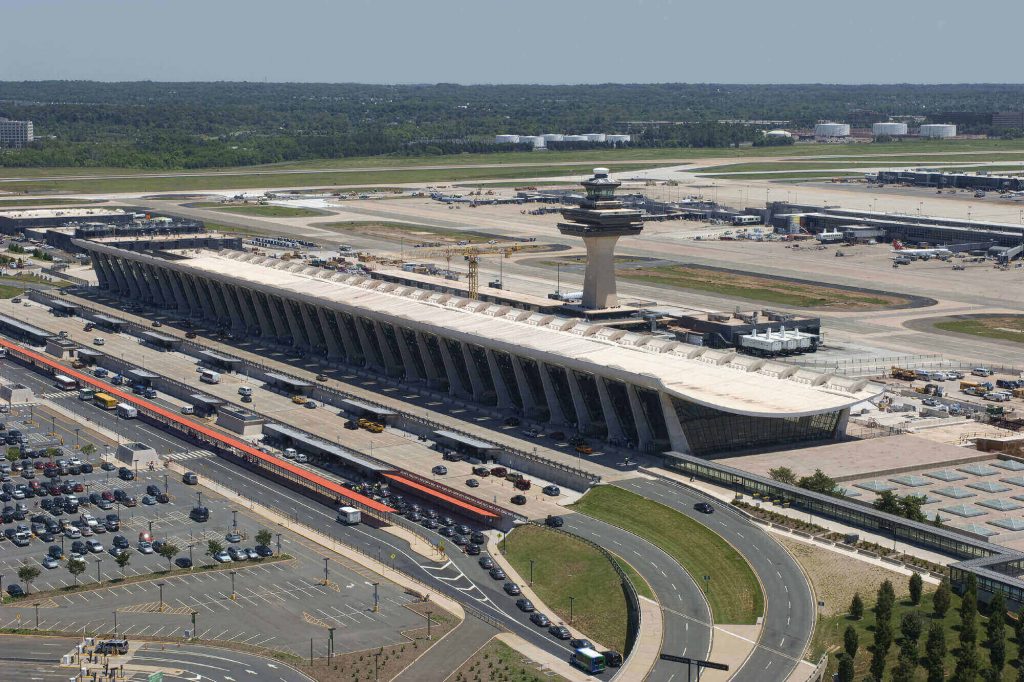
History
- 1958 Construction of Washington International Airport Begins
- 1962 Construction of Terminal complete
- Official operations begin at “Dulles International Airport”
- Dulles Access Road Opens
- Air Cargo Building 1 opens
- 1966 Dulles handles more than 1 million passengers
- 1970 Marriott Hotel opens for business
- Air Cargo Building 2 opens
- 1973 Air Cargo Building 3 opens
- 1977 North side of jet ramp expanded – first airport expansion project at Dulles
- 1978 Construction begins on additions to the Terminal
- 1982 New baggage make-up area added below the Terminal
- First economy parking lot opens
- 1983 Access Road extension to I-66 complete
- Temporary Concourse C/D opens
- 1984 Airport officially renamed Washington Dulles International Airport
- 1985 Air Cargo Building 4 opens
- Red and Blue economy parking lots open with total of 4,200 spaces
- 1986 Green Economy Lot opens with 4,300 spaces
- Dulles handles more than 10 million passengers
- Bill transferring the operation of National and Dulles Airports to a new regional Airports Authority is signed by President Ronald Reagan.
- 1991 International Arrival Building Opens
- 1992 Terminal expansion begins
- 1993 Air Cargo Building 5 opens
- 1996 Terminal expansion completed, bringing the buildingto 1,240 feet in length and 1.1 million square feet.
- 1998 First permanent concourse opens with 20 gates – Concourse B
- Gold Economy Parking Opens with 1,355 spaces
- 1999 Airport acquires an additional 1,000 acres for future expansion
- Concourse A opens on May 2 to accommodate 36 regional aircraft
- Third lane added to on-airport roadway
- Cargo Building 6 opens
- Purple Economy Lot opens with 4,400 spaces
- 19.8 million passengers travel through Dulles, an increase of 26% from 1998
- 2000 20 million passengers travel through Dulles, including nearly 4 million international passengers.
- 2002 Parking Garage 2 opens at Dulles, adding 3,700 parking spaces
- 2003 Parking Garage 1 opens, adding another 4,700 parking spaces.
- 2004 Passenger Walkway opens at Dulles connecting the Terminal to Concourse B via underground moving sidewalks.
- 2005 Airport acquires an additional 830 acres for future expansion
- Z Gates open, adding permanent airline gates to the Terminal
- New Airport Traffic Control Tower construction completed
- 2007 New Airport Traffic Control Tower becomes operational and is dedicated on Sept. 17 by the Federal Aviation Administration.
- 2008 15-gate expansion of Concourse B opens on January 15.
- Fourth Runway (1L/19R) opens on November 20.
- 2009 Construction of the AeroTrain System is completed; testing begins.
- Two New Security Mezzanines open on September 15.
- The first phase of the IAB expansion opens on September 22.
- 2010 The AeroTrain System opens on January 26.
- 2011 A major expansion of the International Arrivals building is completed.
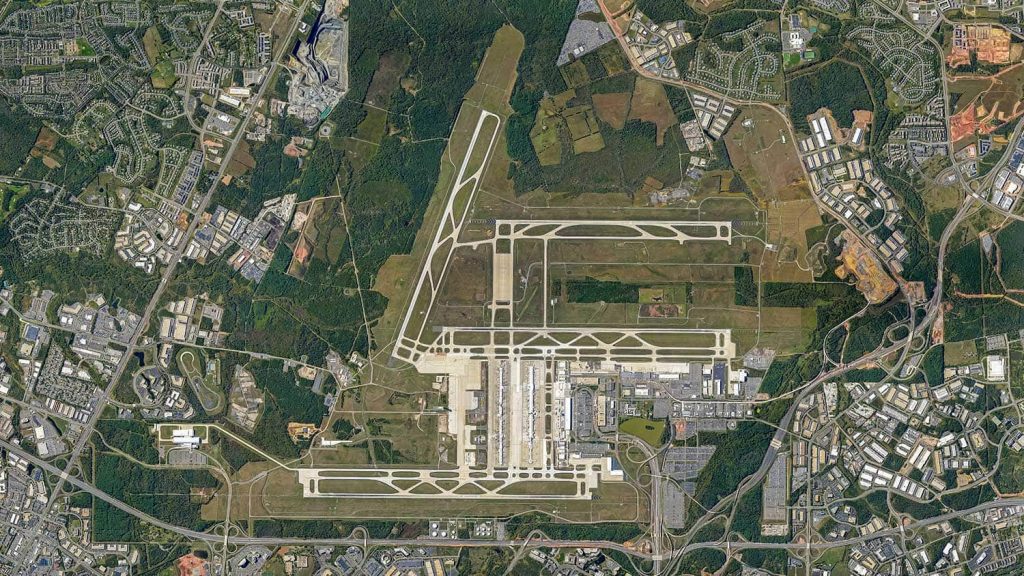
Terminals
The airport’s terminal complex consists of a main terminal (which includes four of the original gates, “Z” gates), and two parallel midfield terminal buildings: Concourses A/B and C/D.
The entire terminal complex has 123 gates and 16 hardstand locations from which passengers can board or disembark using the airport’s plane mate vehicles.
Inter-terminal transportation
Conceived in early planning sessions in 1959, Dulles is one of the few remaining airports to use the mobile lounge (also known as “plane mates” or “people movers”) now only used for transport to the International Arrivals Building as well as transport for Concourse D.
They have all been given names based on the postal abbreviations of 50 states, e.g., VA, MD, AK.
The Metropolitan Washington Airports Authority has gradually phased out the mobile lounge system for inter-terminal passenger movements in favor of the AeroTrain, an underground people mover which currently operates to all of the concourses except concourse D, with passenger tunnels remaining to concourses A and B.

Main terminal
Dulles’s iconic main terminal houses ticketing on the upper level, baggage claim and U.S. Customs and Border Protection on the lower level, and annexes for the International Arrivals Building for international passenger processing, as well as the Z gates (used by Air Canada, Frontier and United Express), various information kiosks and other support facilities.
The main terminal was recognized by the American Institute of Architects in 1966 for its design concept; its roof is a suspended catenary providing a wide enclosed area unimpeded by any columns.
The main terminal was extended in 1996 to 1,240 feet (380 m)—Saarinen’s original design length—which was slightly more than double its originally constructed length of 600 feet (180 m).
On September 22, 2009, an expansion to include the 41,400 square feet (3,850 m2) International Arrivals Building opened for customs and immigration processing with a capacity to process 2,400 passengers per hour.
Also in September 2009, a 121,700 square feet (11,310 m2) central security checkpoint was added on a new security mezzanine level of the main terminal.
A separate security checkpoint is available on the baggage claim level. Both security checkpoints connect to the AeroTrain, which links the main terminal with the A, B, and C concourses.
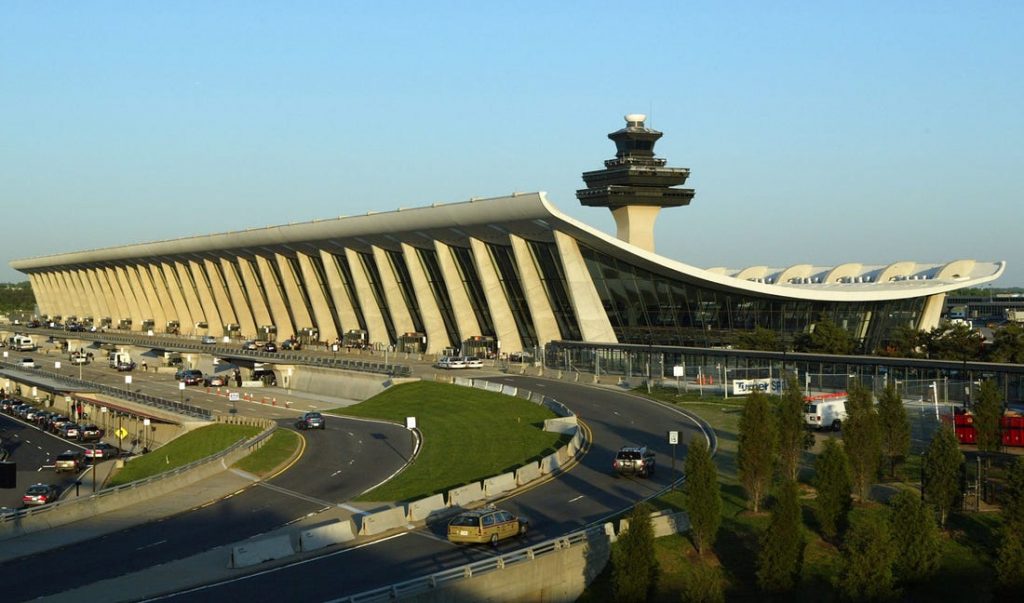
Midfield terminals
All airlines aside from Air Canada Express, Frontier Airlines, and United Express operate out of two linear satellite terminals which are Concourses A and B, and Concourses C and D.
Concourses A and B
All non-United flights operate out of these two concourses as well as some United Express flights. Concourse A (which has 47 gates) composes the eastern part of the closest midfield terminal building.
It consists of a permanent ground level set of gates designed for small planes and regional jets used by United Express, and several former Concourse B gates.
Concourse A’s AeroTrain station is located about halfway through the concourse, between gates A6 and A14.
Concourse B (which has 28 gates) composes the western half of the building. It is the first of the permanent elevated midfield concourses.
Originally constructed in 1998 and designed by Skidmore, Owings & Merrill and Hellmuth, Obata and Kassabaum, the B concourse contained 20 gates. In 2003, 4 additional gates were added to concourse B, followed by a 15-gate expansion in 2008.
In addition to the AeroTrain station located between gates B51 and B62, Concourse B also has an underground walkway to connect it to the main terminal.
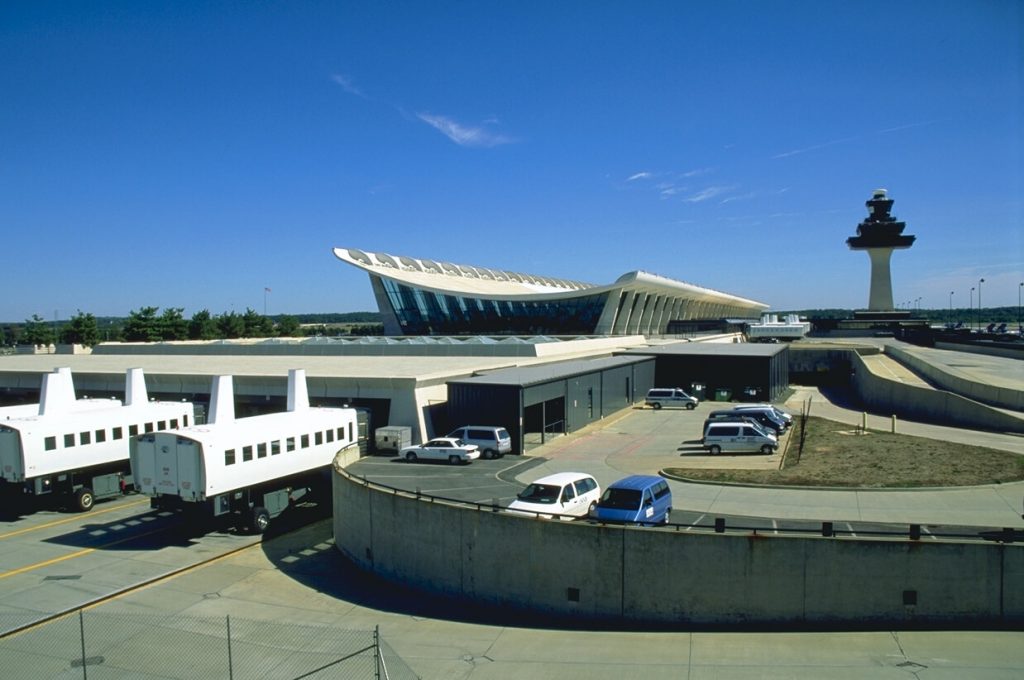
Concourses C and D
Concourses C/D are solely used for United Airlines flights, as it functions as their hub at IAD.
All mainline United flights and most United Express regional jet operations operate out of these concourses (some United Express flights use Concourse A).
These concourses were constructed in 1983 and designed by Hellmuth, Obata and Kassabaum. The two concourses have 22 gates each, numbered C1–C28 and D1–D32, with odd-numbered gates on the north side of the building and even numbered gates on the south side.
Concourse C composes the eastern half of the terminal and Concourse D composes the gates on the west half of the terminal.
The C/D concourses were given a face lift in 2006 which included light fixture upgrades, new paint finishes, new ceiling grids and tiles, heating and air conditioning replacement, and complete restroom renovations.
Concourse C also has a dedicated Federal Inspection Station located at ground level. International United flights not originating at an airport with US customs pre-clearance can directly deplane passengers via the jet bridge at Concourse C (as opposed to using plane mates to offload passengers).
Once deplaned, arriving passengers are separated. Passengers terminating at Dulles take a mobile lounge that transports them to the International Arrivals Building, while connecting passengers continuing on another United flight go through U.S. Customs and Immigration at the FIS station on the ground level.
Since this immigration facility is only for connecting passengers on United and other Star Alliance carriers, it has shorter lines and passengers don’t have to re-clear security at the massive security checkpoints in the main terminal.
A new and permanent C/D concourse (also called “Tier 2”) is planned as part of the D2 Dulles Development Project. The new building is to include a three-level structure with 44 airline gates and similar amenities to Concourse B.
The concourse plan includes a dedicated mezzanine corridor with moving sidewalks to serve international passengers. The design and construction of the new C/D concourse has not been scheduled.
When built, it is planned that both terminals will be connected to the main terminal and other concourses via the AeroTrain.
To that extent, the AeroTrain station at Concourse C was built at the location where the future Concourse C/D structure is proposed to be built, and is connected to the existing Concourse C via an underground walkway.
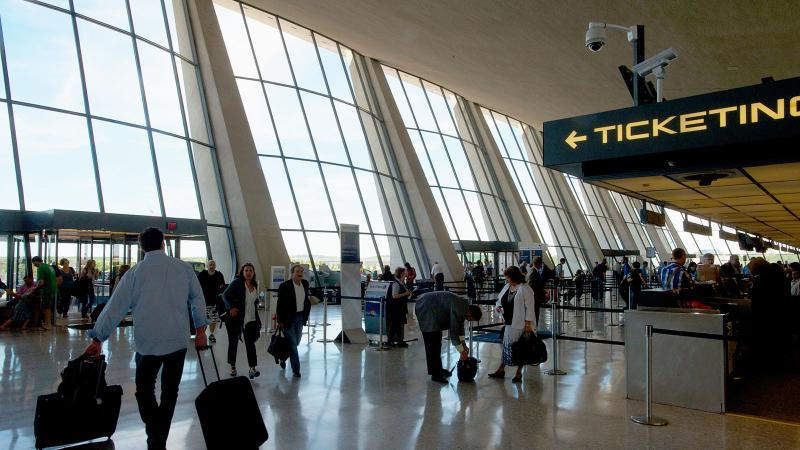
Dulles International Airport Data
- Country
- America
- Region
- North America
- Status
- In use
- Location
- Dulles, Virginia, U.S.
- Owner(s)
- Metropolitan Washington Airports Authority
- Official website
- flydulles.com
- Operator(s)
- Metropolitan Washington Airports Authority
- Began
- Sep-02, 1958
- Opened
- Nov-17, 1962
- Airport type
- Public
- Airport code
- IATA: IAD, ICAO: KIAD, FAA LID: IAD
- Airport area
- 12998 acres / 52.6 km²
- Runway length
- 2*3505 m,1*2865 m,1*3201 m
- Passenger traffic
- 24.8 million(2019)
- Freight volume
- 273,385 tons (2019)
- Takeoffs and landings
- 285,042 sorties (2019)
View Dulles International Airport on Google Satellite Map
Google satellite maps allow you to see building details more clearly, including natural landscapes such as mountains, rivers, deserts, sea and man-made engineering buildings.
If you are very interested in this engineering building, it is a good idea to click below Google Map icon. We will help you jump to the corresponding location of this building or engineering on Google satellite map.






























































